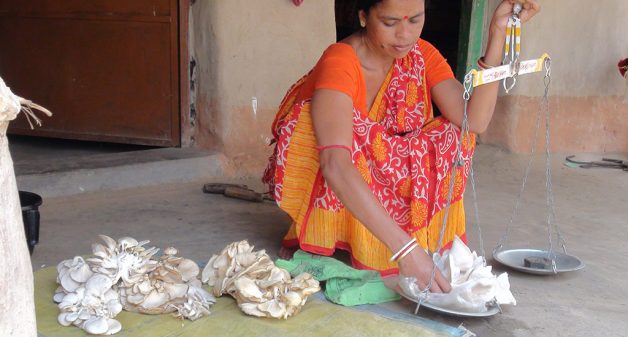
Mushroom cultivation becomes lifeline
After years struggling on paltry incomes, growing mushrooms provides West Bengali women better livelihoods and nutrition – and gives urban India more varieties.

After years struggling on paltry incomes, growing mushrooms provides West Bengali women better livelihoods and nutrition – and gives urban India more varieties.
Nazima Begum, who lost her husband six years ago, eked out a living for herself and her teenage son by stitching clothes. It was a tedious and debilitating work that earned the Bengali about Rs 3,500 a month – barely enough to run her household.
Until she discovered mushroom farming. Begum now propagates mushroom spawns from her own kitchen, giving her handsome returns without the painful work. “Stitching was very tedious and involved several hours of work, leading to severe back pain and strain in my eyes. The income was also very little,” said Begum, who lives in Pathanpara village, 160 kilometers from Kolkata.
But to prepare 10 kilograms of spawns, it takes her just a few hours. After about a month of watering and monitoring the spawns, she packs them in polythene bags and sells each 200 gram bag for Rs 22. “It brings me good profit since the propagation cost is just Rs 5. My entire focus is on propagating spawns nowadays,” she said with a smile.
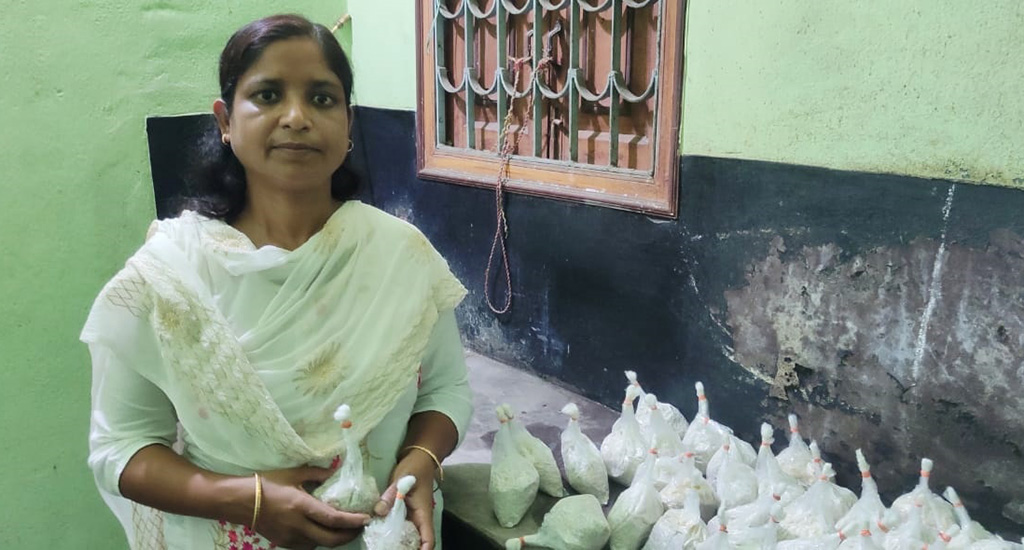
And she’s not the only one. Begum is one of over 300 women in seven panchayats of West Bengal’s Purba Bardhaman district who now have an alternative livelihood through mushroom farming.
Rural livelihood training
In 2017 the Bharat Rural Livelihoods Foundation’s Usharmukti Project started offering livelihood training for rural women, most of them tribals. The project did a survey that found the women did not have enough land to do their own farming. While they worked on other farms and did other small jobs, it did not provide them enough income to run their households.
“Most men migrated to other states for better livelihood. But women were not allowed to step outside their house for jobs, because of their family’s patriarchal mindset,” said Amlendu Ghosh, vice president of Loka Kalyan Parsihad, the project’s implementing non-profit agency.
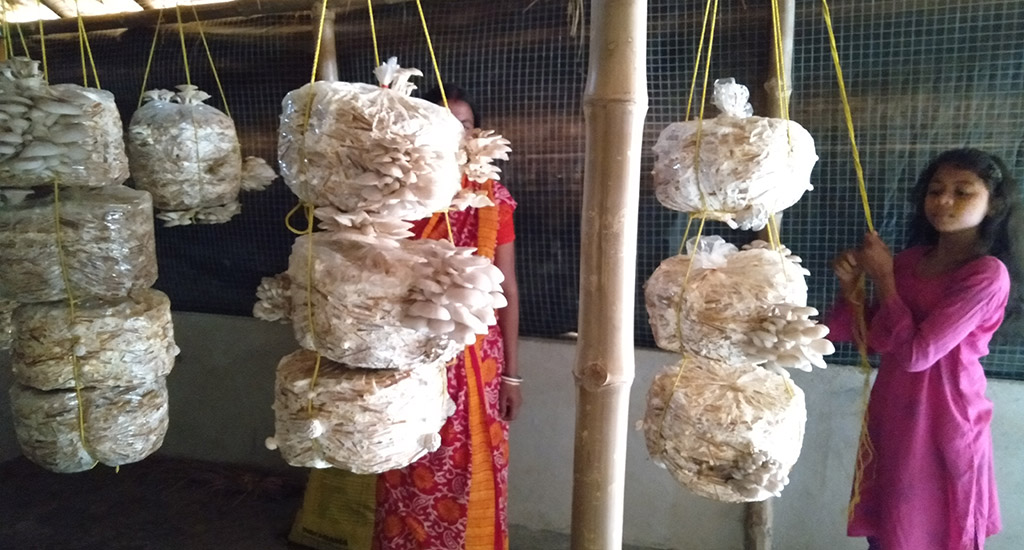
So the agency decided to train the women in alternative livelihoods to help them bear some of their family’s expenses. Mushroom cultivation was a perfect fit.
Homebound work and improved nutrition to boot
One major benefit of growing mushroom is the small amount of space required to get the job done. But that’s not all. It provides healthy food source too.
“We gave importance to mushroom farming because they can be cultivated inside the house and would provide healthy diet to the family,” said Ghosh. “It takes nearly a month to harvest and brings good returns. Besides, it doesn’t involve hard work, except constant monitoring and watering.”
Despite having occasionally consumed mushrooms collected from the forest, the women were reluctant to foray into mushroom cultivation as they were apprehensive about the market demand.
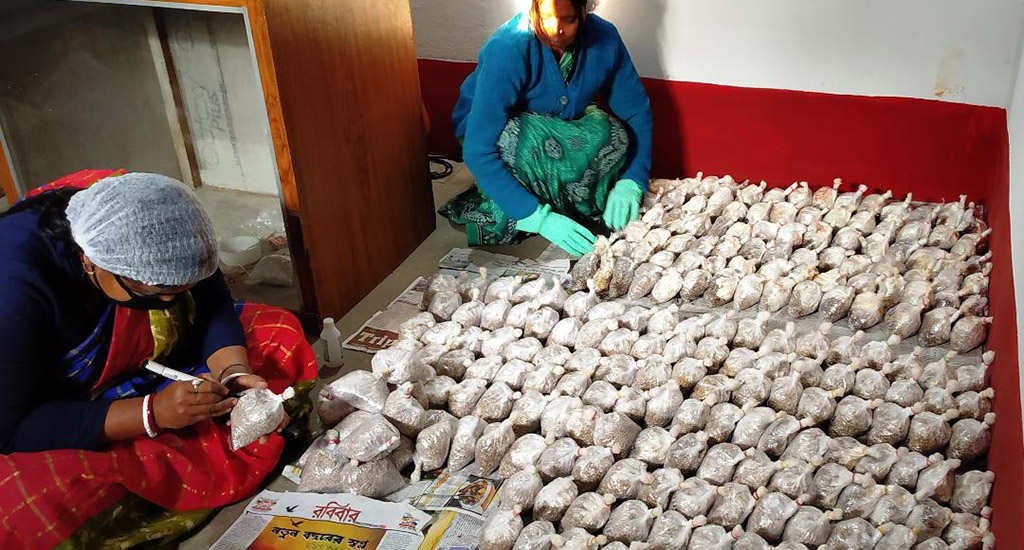
Realizing this, Loka Kalyan Parsihad distributed spawns for free. “We offered the spawns to create awareness. Initially, the idea was not to commercialize, but to offer nutritious food for their family, especially children,” said Ghosh.
The idea paid off. Women slowly began to show interest, taking to the delicious taste and nutrition of mushrooms. Deciding to grow them on a larger scale, the women started purchasing spawns from the non-profit agency.
Market potential and pitfalls
“Around 200 gram of spawn can produce 2 to 2.5 kg of mushrooms. The production cost is around Rs 30 per kg while they can be sold for as high as Rs 200 per kg depending upon the demand and locality,” Satyanarayan Sardar, an expert on mushrooms and also team leader of Usharmukti project in Purba Bardhaman told VillageSquare.in.
Sensing good profits, women took to growing mushrooms. Mousumi Singha, a data entry operator who started growing last year said, “Of the 37 kg produced, I sold 27 kg at Rs 200 per kg that brought me a profit of over Rs 5,000.”
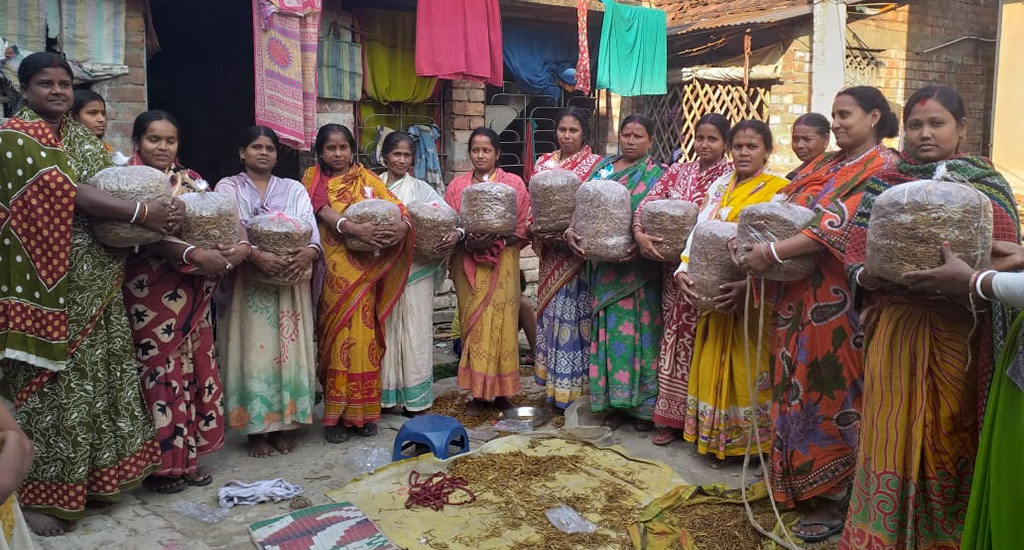
But some women admit to facing severe losses due to inadequate knowledge and miscalculating the market need. “We produced 130 kg recently, but we couldn’t sell them because we had produced too much. Half the mushrooms rotted. But it is profitable if done with caution,” said Reena Sukdar, resident of a neighboring village.
Government builds mushroom sheds
Realizing the immense potential of mushroom cultivation, the state government chipped in and built 17 sheds in January. The sheds – made of concrete floors and straw roofs with walls covered in plastic to aid cultivation – are helping 115 women. The state government also gave each woman twenty packets of spawns to get them started.
“The government is willing to construct additional sheds if more women come forward. We will give priority to those who show serious interest in the business, as some people start farming with enthusiasm but lose interest and quit halfway through,” Arjun Dasgupta, local joint block development officer told VillageSquare.in.
Mushrooming market
Across India there is a growing demand for mushrooms too. Variety is key for the urban gastronome, whose tastes range from ordinary white button mushrooms, often used in salads and pizzas, to more flavorsome varieties, like the oyster mushroom, needed for Chinese and Japanese dishes.
“We emphasized on oyster mushroom as it grows well in local climatic conditions from October to February, more nutritious and requires less space than the other varieties,” pointed out Satyanarayan Sardar.
With both demand and supply growing, the market is expected to mushroom.
Gurvinder Singh is a journalist based in Kolkata. Views are personal.